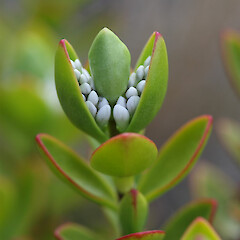Veronica decumbens
Common name
hebe
Synonyms
Hebe decumbens (J.B.Armstr.) Cockayne et Allan
Family
Plantaginaceae
Flora category
Vascular – Native
Endemic taxon
Yes
Endemic genus
No
Endemic family
No
Structural class
Trees & Shrubs - Dicotyledons
NVS code
The National Vegetation Survey (NVS) Databank is a physical archive and electronic databank containing records of over 94,000 vegetation survey plots - including data from over 19,000 permanent plots. NVS maintains a standard set of species code abbreviations that correspond to standard scientific plant names from the Ngä Tipu o Aotearoa - New Zealand Plants database.
HEBDEC
Chromosome number
2n = 40
Current conservation status
The conservation status of all known New Zealand vascular plant taxa at the rank of species and below were reassessed in 2017 using the New Zealand Threat Classification System (NZTCS) – more information about this can be found on the NZTCS website. This report includes a statistical summary and brief notes on changes since 2012 and replaces all previous NZTCS lists for vascular plants.
Please note, threat classifications are often suggested by authors when publications fall between NZTCS assessment periods – an interim threat classification status has not been assessed by the NZTCS panel.
- Conservation status of New Zealand indigenous vascular plants, 2017 . 2018. Peter J. de Lange, Jeremy R. Rolfe, John W. Barkla, Shannel P. Courtney, Paul D. Champion, Leon R. Perrie, Sarah M. Beadel, Kerry A. Ford, Ilse Breitwieser, Ines Schönberger, Rowan Hindmarsh-Walls, Peter B. Heenan and Kate Ladley. Department of Conservation. Source: NZTCS and licensed by DOC for reuse under the Creative Commons Attribution 4.0 International licence.
2017 | Not Threatened
Previous conservation statuses
2012 | Not Threatened
2009 | Not Threatened
2004 | Not Threatened
Brief description
Low growing erect twigs bearing pairs of oval dished leaves with a red band on the outer edge and tiny hairs on the margin towards the tip (lens needed) inhabiting Marlborough mountains. Twigs dark red, with bands of hairs. Leaves 6.5-23.5mm long by 2-13mm wide. Flower spike to 3cm long.
Distribution
South Island - Primarily on drier mountains of Marlborough, South-East Nelson and north Canterbury, from the Awatere Valley in the north to the Waiau Valley in the south, and as far west as the Matakitaki Valley (near Mount Baldy).
Habitat
In grassland or low shrubland in rocky, open areas.
Detailed description
Openly branched. spreading low shrub to 0.35 m tall. Branches decumbent to erect; branchlets purplish-red to almost black, pubescent, hairs bifarious (usually) or uniform; internodes 1.5-16.5 mm; leaf decurrencies obscure to evident. Leaf bud distinct; sinus absent. Leaves erecto-patent; lamina elliptic (often broadly) or obovate or oblanceolate, concave, 6.5-23.5 x 2-13 mm; apex subacute or acute; midrib not thickened or depressed to grooved above and thickened below, only sometimes faintly evident in fresh leaves; margin ciliate (with very short, stiff hairs) or glabrous (only very rarely, with hairs usually present at least near apices of youngest leaves), almost always tinged red; upper surface dark green, glossy, with many stomata, glabrous. Inflorescences with 2-25 flowers, lateral, unbranched, 0.6-3 cm, longer than (usually) to shorter than (rarely) subtending leaves; peduncle 0.15-1.6 cm; rachis 0.4-2.4 cm. Bracts alternate (although lower-most bracts may be in a more or less opposite pair, or whorl of three), deltoid (sometimes narrowly) or ovate, acute (usually) to obtuse. glabrous outside. Flowers hermaphrodite. Pedicels 0.2-1.7 mm, hairy or sometimes glabrous. Calyx 1-3 mm. 4-5-lobed (5th lobe small, posterior); lobes deltoid or ovate, acute or acuminate or obtuse, with mixed glandular and eglandular cilia (glandular cilia sometimes greatly outnumbering eglandular cilia). Corolla tube glabrous, 3-6 x 1.8-2 mm, cylindric and contracted at base, much longer than calyx; lobes white at anthesis, elliptic (sometimes broadly) or ovate, obtuse (usually) to acute (posterior sometimes slightly emarginate), suberect to patent, shorter than corolla tube. Stamen filaments at least slightly incurved at apex in bud, 4.2-7 mm; anthers magenta, 1.6-2 mm. Ovary 0.9-1.1 mm; ovules 17-20 per locule; style 6-10 mm. Capsules subacute, 2.5-5.5 x 2-3.5 mm, loculicidal split extending ¼-½-way to base. Seeds flattened, ovoid to ellipsoid to oblong, more or less finely papillate, brown, (1-)1.2-1.7 x0.8-1.3 mm, micropylar rim 0.3-0.7 mm.
Similar taxa
A distinctive species recognised by the combination of a decumbent habit, dark branches that are often bifariously hairy in broad bands, glossy leaves, leaf margins that are usually red (except in plants from the Black Birch Ra.) and minutely ciliate, especially toward the apex, long corolla tubes, and bracts not extending beyond tips of calyces. It shows some variation in the shape of the leaves (from broadly to narrowly elliptic) and leaf apices (from barely subacute to acute). Herbarium specimens have frequently been misidentified as V. pinguifolia (with which it sometimes co-occurs). and vice versa. V. pinguifolia can be distinguished by its usually glaucous leaves, usually shorter pedicels, larger bracts, and relatively shorter corolla tubes.
Flowering
(November-) December - February
Flower colours
White
Fruiting
January May (-December)
Life cycle
Seeds are wind dispersed (Thorsen et al., 2009).
Etymology
veronica: Named after Saint Veronica, who gave Jesus her veil to wipe his brow as he carried the cross through Jerusalem, perhaps because the common name of this plant is ‘speedwell’. The name Veronica is often believed to derive from the Latin vera ‘truth’ and iconica ‘image’, but it is actually derived from the Macedonian name Berenice which means ‘bearer of victory’.
decumbens: From the Latin decumbere ‘to lie down, recline’, in botany refers to creeping plants with upright tips
Attribution
Description adapted by M. Ward from Bayly & Kellow (2006).
References and further reading
Bayly, M.J., Kellow, A.V. 2006. An illustrated guide to New Zealand Hebes. Wellington, N.Z.: Te Papa press pg. 158.
Thorsen, M. J.; Dickinson, K. J. M.; Seddon, P. J. 2009. Seed dispersal systems in the New Zealand flora. Perspectives in Plant Ecology, Evolution and Systematics 11: 285-309







